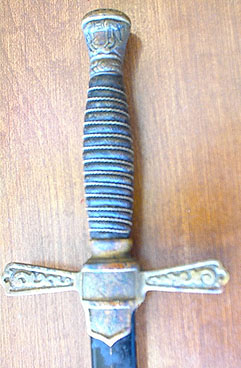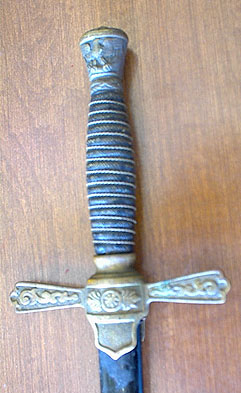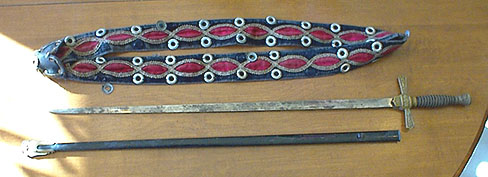Military Association Sword

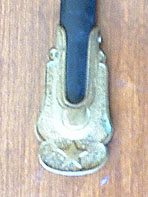
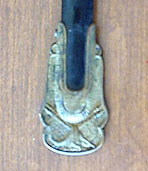
The following is another one of these "military association" swords
that I cannot positively identify. It could be a Military Bandsman (Musician), Cadet, Militia, Society, or other
Military Association Sword, from the period of about 1860 to perhaps about 1920. It is very similar to
another Unidentified Sword 1860-1890 listed in this section.
The hilt is mostly of cast brass, but the grip is of a cast ray-skin texture - blackened - and wrapped in a twisted-brass wire - as
with many military regulation swords; the cross-guard and langet are very similar to Ames-made militia
swords of the 1850-1870 period. The cross-guard quillons have a framed scroll-like pattern; between the
quillons on the "front side" or obverse, is a pattern which looks like an "eight-spoked wheel"
flanked by a pattern resembling feathers or leaves; the "reverse" side is plain except for "textured"
background (as is background on the front). The langets are in the pattern of a shield (chevron), both sides.
The pommel is integral to the grip and is attached
by method of peening and deforming the tang; the front side of the pommel bears a standing eagle
(grasping a branch), wings spread, head facing right. The reverse displays a winged shield framing
a smaller shield; this smaller shield is worn, so any design cannot be ascertained. Below the pommel, above
the wire wrap, is a pattern encircling the grip resembling wheat; the butt of the pommel has a floral or
scroll-work design.
The blade is 28 1/8" long; blade cross-section is a narrow diamond shape ~ 1/8" to 3/16" in width.
The blade is un-fullered; doubled edged but edges are flat, not sharpened. The sword is obviously intended
for thrusting purposes as the tip is narrowed and sharp. Blade is unmarked, so maker is not immediately apparent.
The scabbard is 29 1/2" long, including drag. It is metal with black "enameled" finish.
The drag is solid brass, retained by one screw near the top, obverse. At the bottom of the drag obverse is star that
might indicate some Texas association; reverse is a pattern that is obviously the colors (flag, whose I do not know) draped over one set of lances and possibly draped
over a second set in the background. The frog stud is brazed on and is ~ 1/2" in diameter.
Further thoughts -
The "eight-spoked wheel" has significance in most religions; it is an ancient symbol representing the cycle
of life - often called the "Wheel of Law, Truth, and Life" - each spoke representing the "Noble Eight-fold Path"
(the path consisting of the "right faith, values, speech, conduct, livelihood, endeavor, awareness, and meditation).
Wheat because it is sown, grown, and then harvested (reaped) is used to signify the cycle of "birth, life, and death,
as well as re-birth."
Because of the similarity of these two symbols, I suspect this is a sword belonging to a secret society initiated after -
possibly as a direct result of - the Civil War.
These symbols have also been observed on Medical and Payroll Officer's swords. It is very possible the sword has "Southern"
origins and the symbols signify the "birth, life, death, and re-birth" of the Confederacy."
Other symbols - such as on
the scabbard - lead me to believe this could be a "militant" society.
This particular example came with a cross-shoulder sword-belt and may help identify the association in the future.
